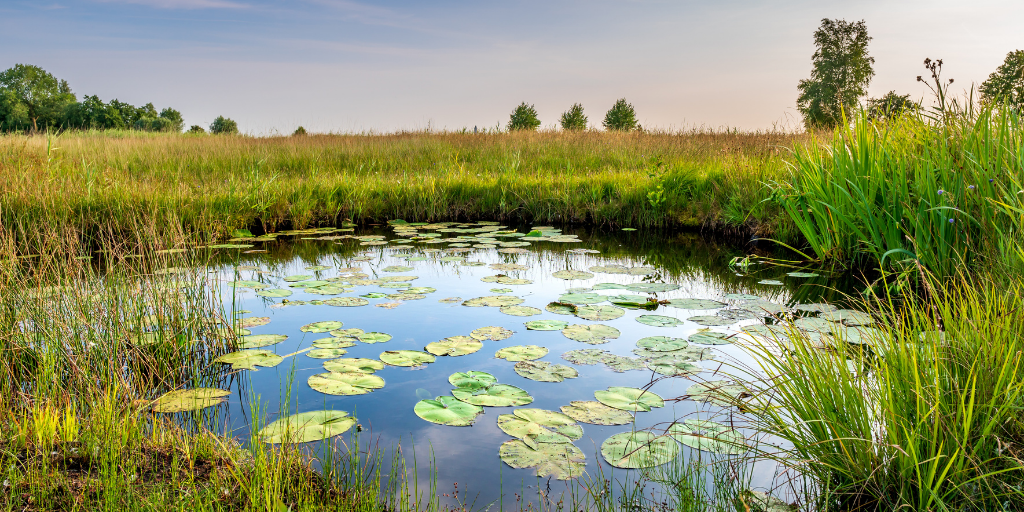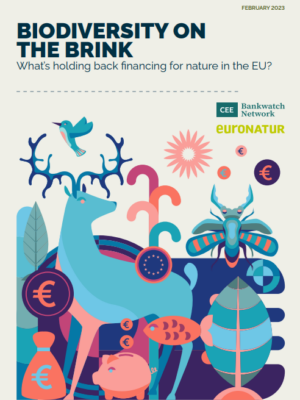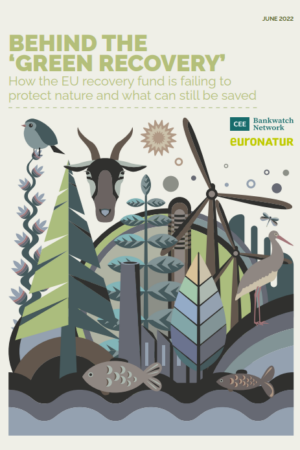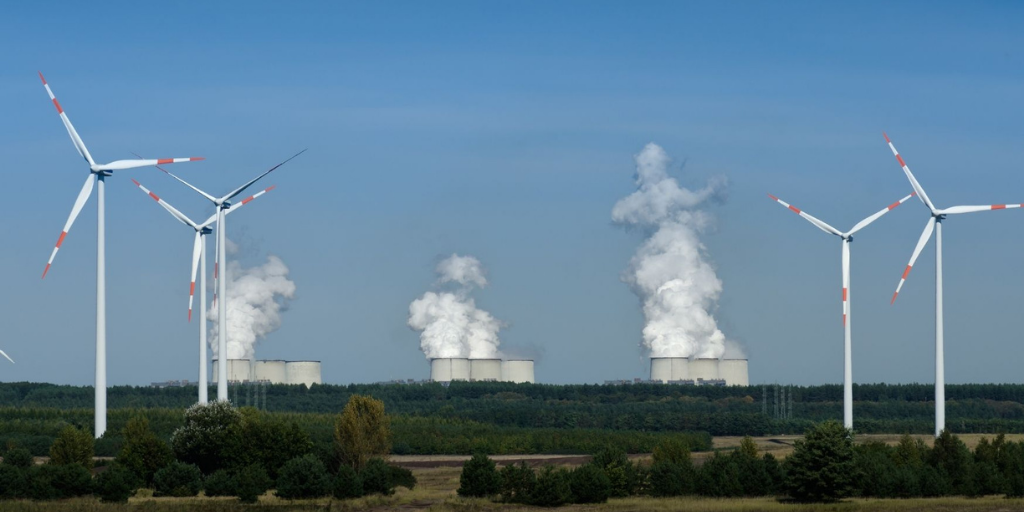EU funds and biodiversity
Nature is in crisis. 81 per cent of habitats in the EU are in ‘poor condition’, and without swift action this will only become worse. We need systemic and wide-reaching action and investments to tackle biodiversity loss and help restore nature before it is too late. The EU has pledged 120 billion of the EU budget to be earmarked for biodiversity by 2026, offering enormous potential to restore and protect nature, providing this is properly invested. We are therefore campaigning to ensure these public funds work for – not against – nature.

Stay informed
We closely follow international public finance and bring critical updates from the ground.
Key facts
In May 2020, the EU released the Biodiversity Strategy for 2030 aimed at both restoring and protecting biodiversity across the EU.
The EU aims to allocate 7.5 per cent of the EU budget to biodiversity action by 2024, followed by 10 per cent till 2026.
By 2030, the EU has a target to protect 30 per cent of land and sea.
Investing in nature is key to tackling climate change. EU forests currently absorb the equivalent of 8.9 per cent of the EU’s total greenhouse gas emissions. Improved management could allow this to be doubled.
Key issues
Biodiversity needs increased funding
Our analysis of ten CEE countries’ recovery plans found that just 0.3 per cent of recovery funds have been allocated to biodiversity-related investments and reforms. That is just 3 cents for every 10 euros.
Green recovery or business as usual?
The EU’s economic recovery should be a key opportunity to rethink the business as-usual approach that has led to biodiversity destruction. Yet, many Member States have asked for EU public financial support for a new wave of old-fashioned and damaging projects – and in many cases have received it.
Funds must be properly targeted
Investments such as the expansion and better management of Natura 2000 areas, as well as restoration of grasslands, peatlands and habitats need to be favoured instead of investing in harmful activities such as land drainage, unsustainable forestry and hydropower.
Background
In central and eastern Europe, around 41 per cent of all public investments come from EU funds, meaning that these funds can significantly determine the region’s future. The investment decisions made today will therefore shape the region for years to come.
However, Bankwatch has documented numerous cases where EU funds and investments have been damaging to nature, rather than maximising their transformative potential to address the biodiversity crisis.
Working with campaigners across ten central and eastern European Member States, we are advocating for the recovery and resilience facility and cohesion funds to properly invest in biodiversity, while preventing those that are damaging to nature.
Transparent, inclusive and participatory decision making
Allowing the public to actively participate in planning and decision-making processes of EU funds has been shown to deliver better quality projects and higher environmental ambition, as well as creating public ownership and engagement. Therefore, to make the most of EU funds, it is important that all interested people are involved throughout the process, from planning to implementation. In particular, the knowledge and expertise of environmental NGOs is vital for developing programmes that can truly protect and restore biodiversity.
Nature is key to tackling climate change
The biodiversity crisis is equally as important as the climate crisis – the two are interconnected and both must be tackled together. As well as being vital for biodiversity, restoring nature is an important way to adapt to and mitigate climate change; soil, grasslands, peatlands and forests for example are vital carbon sinks and can cheaply and effectively sequestrate CO2 emissions. Only by investing in nature can we tackle climate change. Read our report showcasing examples of nature restoration and conservation projects across Central and Eastern Europe here.
Citizens' Observatory for Green Deal Financing
The Citizens’ Observatory for Green Deal Financing advocates at the EU and national levels for more transparency and a just distribution of EU funds. The observatory aims to promote the voices of local communities in seven Member States through a series of workshops, public events, virtual tours, roundtables, reports and other activities.
Biodiversity on the brink
What’s holding back financing for nature in the EU?
Biodiversity in Europe continues to decline each year. The EU has outlined its strategy to address this through the EU Biodiversity Strategy for 2030, which recognises the key role both EU public and private financing plays in addressing the biodiversity crisis. Yet, a number of significant barriers at national level remain, preventing the successful uptake and efficient use of financing for nature.

Behind the ‘green recovery’
The EU’s Recovery and Resilience Facility (RRF), an emergency fund developed in response to the financial crisis caused by the COVID-19 pandemic, provides Member States with an extraordinary EUR 672.5 billion to facilitate a green European recovery. However, rather than using this as an opportunity to protect and restore biodiversity, our analysis shows Member States’ recovery plans will harm nature.
The report reveals harmful reforms and investments set to receive EU recovery funding in nine central and eastern European Member States.
Through these examples, we aim to prevent and/or mitigate the harm they may cause, as well as to ensure similar projects do not receive EU funding in the future.

Supporting biodiversity for Europe’s green recovery
Investments in nature conservation have long been neglected, and as a result, nature across Europe is now in a terrible state. Biodiversity conservation projects can address this by providing cost-effective ways to restore nature and sustainably manage ecosystems; tackle climate change; and deliver environmental, social and economic benefits at the same time.
Latest news
Successful renewables acceleration needs more public participation, not less
Blog entry | 27 February, 2023In December 2022, the Council of the European Union adopted an emergency regulation aimed at speeding up renewable energy deployment. But Member States have to uphold environmental safeguards and consult the public if they don’t want to end up doing the opposite, warns our new position paper.
Read moreRomanian decision-makers attempt misuse of REPowerEU funds for illegal hydropower plants
Press release | 30 November, 2022Romania’s Government plans to use funds allocated under the REPowerEU package to build nine hydropower projects in protected natural areas, Bankwatch Romania has warned the European Commission today.
Read more欧盟为可再生能源紧急开“绿灯”
Bankwatch in the media | 28 November, 2022… 欧盟为可再生能源紧急开“绿灯” …
Read moreRelated publications
Manifesto: A call for the next European Parliament and Commission to deliver the transformative investments citizens deserve
Manifesto | 26 March, 2024 | Download PDFThe proposals outlined in this manifesto guide our vision for how EU public finances can become more transformative.
Led by nature: Projects to protect and restore biodiversity in Europe
Report | 22 March, 2024 | Download PDFThese case studies from several European Member States demonstrate some of the many ways EU funds can and should be used to support nature restoration and conservation projects, which are instrumental to addressing the biodiversity crisis across sectors while also building a greener, fairer future.
Beyond profit: How to reshape the European Green Deal for people’s well-being
Report | 12 March, 2024 | Download PDFThis searing report by the Citizens’ Observatory on Green Deal Financing analyses key EU funding mechanisms and exposes significant shortcomings in strategic priorities and implementation.

